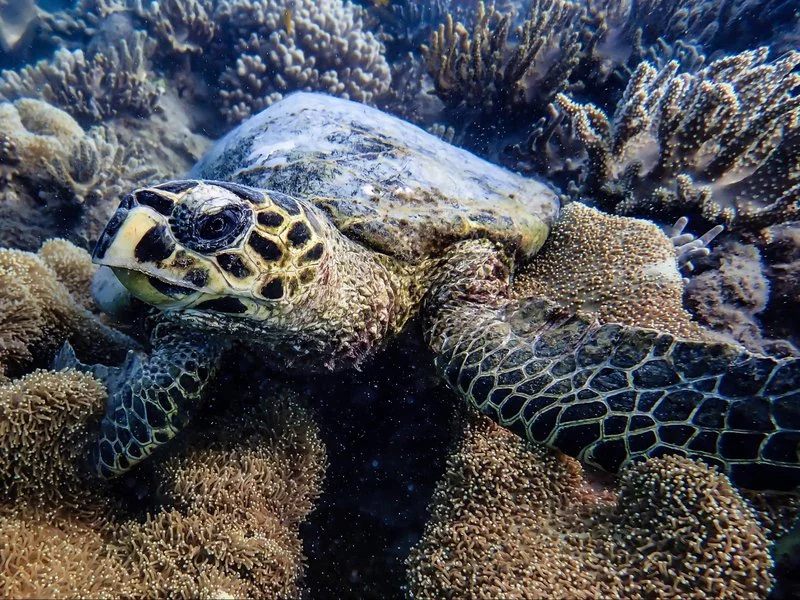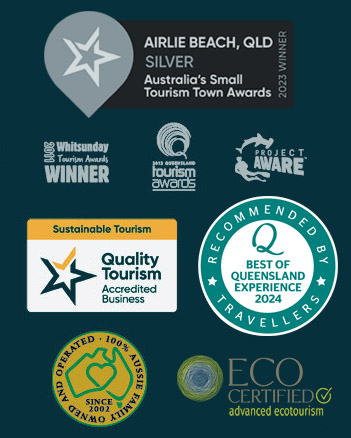One of the best known and most loved groups of marine animals are the sea turtles. They are marine reptiles that have existed on the planet for more than 100 million years and can be found worldwide excluding the freezing waters of the polar regions. Some species of sea turtle are extremely migratory and will cover thousands of kilometres every year to reach breeding and feeding grounds, while others like to stay a little closer to home.
There are currently 7 extant species of sea turtles left in the world. These are the Leatherback, Hawksbill, Flat Back, Kemps Ridley, Olive Ridley, Loggerhead and the Green Sea Turtle. Sadly all 7 of these species are considered to be vulnerable or endangered and this is largely due to human impact through things like habitat destruction and the hunting and collection of the turtles and their eggs for food. Approximately 1 out of 1000 hatchlings survive into adulthood which makes our impact on these species even greater.
On the Great Barrier Reef we are lucky enough to be able to see 6 of the 7 sea turtle species in our waters. These species are the Green Sea Turtle, Hawksbill, Loggerhead, Flat Back, Olive Ridley and the occasional Leather Back.
Green sea turtles are the most common species that you will encounter when you sail and snorkel in the Whitsundays Islands. They are found in all tropical and temperate waters around the world and prefer to live near coastlines and around islands where there are sheltered bays and shores, which is exactly what the Whitsundays has to offer. Wings Sailing Charters Whitsundays offer private charters and all-inclusive holidays for small or large groups, where you will have plenty of chances to interact with these beautiful animals.
These turtles grow to be quite large at around 1.5 meters in length and weighing in at over 100 kilograms fully grown and can live for 80 years or more. These turtles are not named for their shells which are quite beautiful with mottled patterns of green, browns and yellows. They are named for the layer of fat between their shell and organs which has a green tinge.
Like other species of turtle, green sea turtles are migratory and will cover large distances to travel from feeding sites to nesting sites. Mating usually occurs in early summer with females nesting through summer. Green sea turtle eggs usually incubate for 60 days before hatching. After hatching the baby turtles make their way down to the ocean to begin their lives dodging predators and finding food.
As green sea turtles age their diet changes. As hatchlings their diet consists of marine worms, crustaceans, seagrasses and algae and as they age their diet turns more herbivorous with the turtles preferring to feed only on seagrasses and algae. However they do enjoy snacking on jellyfish along with other turtle species.
The seagrass beds and abundance of sheltered bays and shore lines are prime habitat for green sea turtles which means we have quite a healthy population around the mainland and islands. However this is not reflected world wide with the IUCN ( International Union for Conservation of Nature) lists this species as endangered.

Quite the opposite to the petite hawksbill is the loggerhead. Loggerhead sea turtles are named for their large chunky head and strong jaw, they are also the second largest sea turtle species with some individuals found weighing over 400 kilograms. These turtles have one of the widest distributions of all sea turtles species and will travel for extremely large distances to reach prime breeding, nesting and feeding grounds. They are mostly carnivorous and their diet consists mainly of crustaceans and large molluscs, all of which have hard shells which the strong jaw of the loggerhead has no problem crushing.
This large strong turtle has not been able to escape the effects of humans however, they are currently listed as vulnerable.
Flat Back sea turtles are quite a special species as Australia is one of the only places you can see them and the only place in the world where they will breed and nest. As its name suggests the flatbacks shell has a much flatter less domed appearance than other turtle species. Once fully grown adults can read lengths of approximately 1 meter and weigh almost 100 kilograms. The range of flatback turtles is quite small, they don't migrate large distances for mating and feeding, preferring to stay within the waters surrounding the north of Australia. In these warm waters the flatbacks turtles love to feed on sea cucumbers, mollusks, crustaceans, bryozoans, seaweed and of course jellyfish. Also unlike other turtle species the clutch sizes of flatbacks are comparatively low with females usually only laying around 50 eggs per nest. However the hatchlings are the largest of the sea turtle species.
In Australia the Flatback turtle is listed as vulnerable however the IUCN has left this species unclassified due to lack of data.



